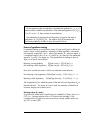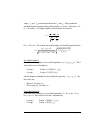
Page 18-42
where Φ(z) is the cumulative distribution function (CDF) of the standard normal
distribution (see Chapter 17).
Reject the null hypothesis, H
0
, if z
0
>z
α/2
, or if z
0
< - z
α/2
.
In other words, the rejection region is R = { |z
0
| > z
α/2
}, while the acceptance
region is A = {|z
0
| < z
α/2
}.
One-tailed test
If using a one-tailed test we will find the value of S
, from
Pr[Z> z
α
] = 1-Φ(z
α
) = α, or Φ(z
α
) = 1- α,
Reject the null hypothesis, H
0
, if z
0
>z
α
, and H
1
: p>p
0
, or if z
0
< - z
α
, and H
1
:
p<p
0
.
Testing the difference between two proportions
Suppose that we want to test the null hypothesis, H
0
: p
1
-p
2
= p
0
, where the p's
represents the probability of obtaining a successful outcome in any given
repetition of a Bernoulli trial for two populations 1 and 2. To test the
hypothesis, we perform n
1
repetitions of the experiment from population 1, and
find that k
1
successful outcomes are recorded. Also, we find k
2
successful
outcomes out of n
2
trials in sample 2. Thus, estimates of p
1
and p
2
are given,
respectively, by p
1
’ = k
1
/n
1
, and p
2
’ = k
2
/n
2
.
The variances for the samples will be estimated, respectively, as
s
1
2
= p
1
’(1-p
1
’)/n
1
= k
1
⋅(n
1
-k
1
)/n
1
3
, and s
2
2
= p
2
’(1-p
2
’)/n
2
= k
2
⋅(n
2
-k
2
)/n
2
3
.
And the variance of the difference of proportions is estimated from: s
p
2
= s
1
2
+
s
2
2
.
Assume that the Z score, Z = (p
1
-p
2
-p
0
)/s
p
, follows the standard normal
distribution, i.e., Z ~ N(0,1). The particular value of the statistic to test is z
0
=
(p
1
’-p
2
’-p
0
)/s
p
.


















